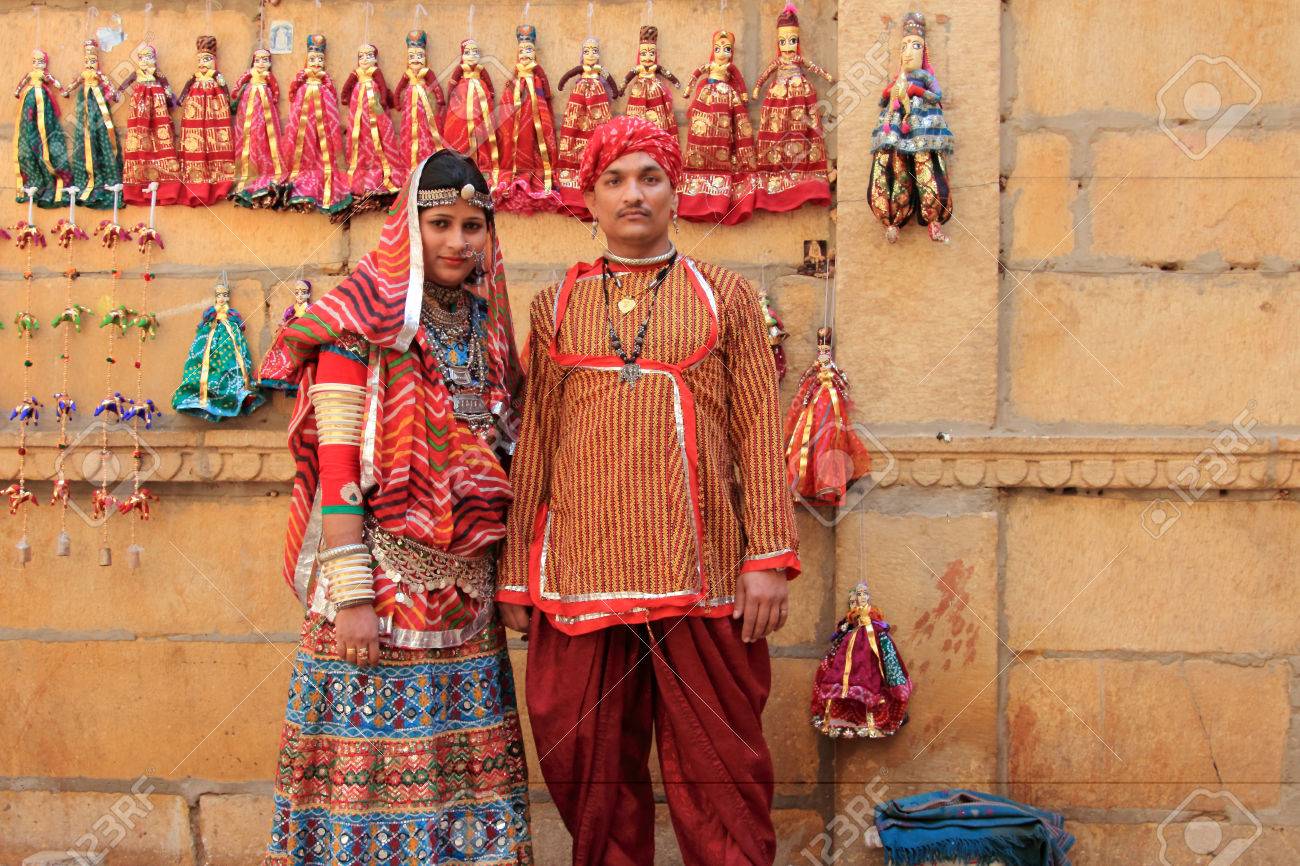Traditional Costumes of Rajasthan :
 Rajasthan is colorful because of what its people wear. The dull-colored monotone of the sands and hills look cheery with the vibrant spirits of the people who wear bright colors to make up for the absence of blossoming flowers. Interesting costumes and jewellery of these desert people are not mere ornaments for them. Everything from head-to-toe including the turbans, clothes, jewellery and even the footwear establishes your identity, your religion and your economic and social status in Rajasthan. The dresses of the males and the females are well defined and is made to suit the climate and conditions in which they live. While pagari (turban), angarakha, dhotis or pyjamas, kamarband or patka (waistband) form integral part of a male's attire, the female's attire includes ghaghara (long skirt), kurti or choli (tops and blouses respectively) and odhani.
Rajasthan is colorful because of what its people wear. The dull-colored monotone of the sands and hills look cheery with the vibrant spirits of the people who wear bright colors to make up for the absence of blossoming flowers. Interesting costumes and jewellery of these desert people are not mere ornaments for them. Everything from head-to-toe including the turbans, clothes, jewellery and even the footwear establishes your identity, your religion and your economic and social status in Rajasthan. The dresses of the males and the females are well defined and is made to suit the climate and conditions in which they live. While pagari (turban), angarakha, dhotis or pyjamas, kamarband or patka (waistband) form integral part of a male's attire, the female's attire includes ghaghara (long skirt), kurti or choli (tops and blouses respectively) and odhani.
Traditional Rajasthani Dresses of Men :
Pagri (Turban) :
Pagri is one of the most important parts of men's attire in Rajasthan as it defines their social and economic status. Their colour, cloth, design and shape- everything symbolises individuality. The width of a Pagri is 8 inches and length is about eighty feet. The common man wears a Pagri of a single colour while a rich man wears a designer multicoloured Pagri. Although people wear special Pagris during festivals or events.
The shape and size of Pagris vary region to region. Pagris of Udaipur are flat, and men of Jodhpur wear safa which have a curved bend. In Jaipur, people prefer an angular Pagri.
Angrakha :
The upper garment is called as Angrakha which means protecting the body, Angrakha is made of cotton. On festivals, people wear designer, multicoloured angrakhas. They are designed in two ways; frock style Kamari Angrakha and knee-length Long Angrakha. Printed Angrakhas are more prevalent in the markets of Rajasthan.
Dhoti / Pyjamas :
Dhotis or Pyjamas are used to cover the lower portion of the body. Mostly white, dhotis are not comfortable to wear and need some practice. But people in Rajasthan wear cotton dhotis on a regular basis. For special events, they prefer a silk one or the one with Zari border or embroidery.
Patka :
A beautiful garment measuring 1.5 m by 1 m, Patka is worn by people of upper class and is mostly made of cotton. It was usually kept on the shoulders or worn around the waist to tuck the weapons in the earlier days. Though it’s no longer in use and has become outdated but one can still see Brahmins wearing patkas with traditional dupattas on their shoulders.
Traditional Rajasthani Dresses of Women :
Ghaghara & Choli :
This long skirt has a narrow waist and broad base, reaching just above the ankles covering the lower portion of the body. It is short to provide visibility to the foot ornaments. They come in many prints and colours. There are many pleats and studded ornaments in the Ghaghara itself. Like Pagaris, they are also found in cotton and printed in laharia. Mothra and chunari. The blouses or short kurtis which Rajasthani women wear are known as cholis. Also made with cotton or silk depending on the occasion, the reach to the waist depends on the caste, religion and age of women.
Odhni :
Odhni is worn over the blouse, with one end tucked into the skirt and the other end on the head or the shoulders. It is made by a 2.5 to 3 meter long and 1.5 to 2-meter wide cloth, printed in different colours and designs. It varies in different religion and castes. At some places, it is mandatory for women to wear Odhni as a veil, especially in front of the elders as a token of respect.
Rajasthan Costumes are very attractive to compare with other traditional dresses. The Indian State of Rajasthan is the unity of colourful festivals, costumes and folk songs and dances. The Rajasthani traditional costumes are very colourful and quite different to the other traditional costumes of rest of the states. The weather conditions of the state bring to wear the myriad colours. The women folk wear more colourful clothes.